13-15#车库雨季渗漏点检查记录表4月
英语中级听力13-15课答案

Lesson13.Section OneTask1. Guess What People Are Talking AboutA. 1----5T F F T F 6.TB.1.wine and good food2. the river3. walking along the river and all the couples4. paintings thereC.1. reminds/of2. got something about it/sort of charm3. unusual/in the center of4. from the top5. down by the riverTask2. Nice to see you!A.1---2.c aB.1—d, I; 2—a; 3—e,f; 4—b, c, f; 5—h; 6—gC. 1. are keeping you busy2. in the process/doing it up3. give you a hand with/something of4. see myself leaving/foreseeable5. my butting in6. over here on a scholarship/the Royal Academy of Music Section TwoTask1. What do you like about your job?A.1----4a c b cB.1----5 F F T F T 6----8 F F TC. 1. a night person2. on the lookout for/ stump me3. plan on sticking around4. the Beatles/a great beat to move toing up with6. at the end of/have slimmed down/built up7. against a tight deadline8. at first/working withTask 2. What do you think of yourself?A. 1-----5: a c a c b 6.aB.1---a. a secretaryb. good at her jobc. different in her private lifed. pretty tide in officee. incoherent in her behavior2---a. concerned about state affairsb. critical of the political systemc. eager to bring law and order to his country3---a. easy-goingb. a bit vicious when upsetc. not sympatheticd. not interested in civil rights4---a. a retired army officerb. respectable and dignifiedc. helpful to those dependent on himd. a bit fanatic about organization and disciplinee. not too polemicf. fond of his wife and family5---a. shy and unhappy during childhoodb. unable to make friends till very latec. good at being by himselfd. self-reliant and independente. fond of childrenSection three1.Bert’s friendship2.Bert and sports3.Adam’s hobbies4.the two men’s religious belief5.Adam---not a creative problem solver6.Heart attack victims enjoy Type B behaviorLesson 14Section OneA. 1.general election in Britain in the near future2. an earthquake killed five people3. stole a quarter of million pounds4. and fifty-seven people were killed in an aircraft crash5. was held in London6. were made to end the strike at Independent Television7.were made when a fight between football supporters of rival teams.B. 1----5: b c a a c 6----8: a b aC.1----5 T T F F F 6----8: F F TD. 1.The Prime Minister2. In center Ttaly/avalanches/the earthquake during the night3. three masked men/with shotguns/unlock the van4. two hundred and fifty-seven people/hit the side of a volcano5. a basis for negotiations/the chances of success6. fifteen people/in court in Manchester/matches in London Section TwoTask1. Bearded LadyA.Answer the following question briefly.1.What is special of Mrs. Clark?She was a bearded woman.2.What advice did all those specialists offer her?They advised her to shave.3.When did she decide to let her beard grow?When she realized that she was fighting a losing battle.4.What was it like being stared at all day?At first it was a bit unnerving.5.Is there any advantage of her beard?Her beard keeps her husband’s toes warm on cold nights.B 1----5 F F T T T 6----8: F T FC.1. at an enormous rate/five inches2. trying to keep it down/fighting a losing battle3. chop off a few feet4.the point and laughing in the endTask2. At a youth CenterA. 1----5: a c a a c 6 bB. a. drinking under the age of sixteenb. music at the dance ballc. language they used. their hair and clothesC. 1----5 F T T F T 6 FD.1. turned me out2. wrong3. on at my boy about4. with5. there’s any need/ take part in6. sitting in on/take you up on7. take you out your wayE. 1. Why does Mrs. Brent refuse to dance?Because she does not think the music played in the hall is of her generation.2. Why does Finchley say that the so-called generation gap is only a myth? Because he believes the young people are quite traditional in their attitudes and they are not that different from the old generation.3. How does James explain eth seemingly different language used by the young people?He believe that every generation creates its own special language as well as its own styles in clothes and music.4. Why does Finchley suggest Mrs. Brent to read a book entitled Britain’s Sixteen-Y ear-Olds?Because he hopes Mrs. Brent to have a better understanding of the young people. Section three1.trading without money---barter2.how money came3.shifting from barter society to a monetized world4.different money values in different countries5.why difficult to give examples of barter deals6.prospect of barteringLesson15Section OneA.1----4: a c b cB.1----5: F TT F TCGroup Aa.killers deserve death penaltyb.Death penalty will prevent other people from killingc.It is important to get rid of the bad seed.d.Criminals are never rehabilitated, they are hardened.e.Some people are just bad, evil, and there is nothing one can do.Group Ba.nobody has the right to take another person’s life.b.Nobody is sure that the person convicted is really guilty.c.Criminals should be rehabilitated instead of being eliminated.d.There should be more extensive programs.e.It is a social problem. We and society are responsible.D.1. Why doesn’t the second speaker believe that we are sure the person convicted is really guilty?Because she has doubts on the lawyers and the judicial system today.2. why doesn’t the first speaker trust the present rehabilitation program?Because studies show that criminals are never rehabilitated.3. what does the second speaker suggest to improve the rehabilitation program?She suggests to expand the program to an extensive one.4. what are the two reasons given by the first speaker for not keeping murders injail?(1) the jails and prisons are already crowded.(2) the taxpayers have to pay to maintain murders’ lives.Task2. A new way of lifeA.1. who are being interviewed?Michelle Burns and Luke Saunders.2. what’s special about them?They have given up regular jobs and high salaries and begun a new way of life3. why did Michelle and her husband decide to come to live in a remote area of Scotland?Because they had worked long hours and had hardly seen each other. As a result, their marriage was breaking up.4. how do they make a living now?They raise sheep and goats, grow their own vegetables, and they have some chickens.6.what is unusual of Mr. Luke Saunders?He had been a car factory worker on the assembly line.7.what did he do for money?He had a bit of money to start with, then he began to do odd jobs like picking fruit, washing up, etc.8.what is he going to do now?He is going to start a new journey in the opposite direction. And he will be away for three years again.B 1----5 F T F F F 6-----10: T T F T FC. 1. leave the “rat race”2. fell in love with3. in it for profit4. on the farm/feel lonely5. four nuts on the bolts6. giving up/turning round/coming homeSection TwoTask1.A.1---3: c a bB. a. forgetting of proper namesb. forgetting of foreign wordsc. childhood and concealing memoriesd. mistakes in speeche. mistakes in reading and writingC. 1. be traced back to/problem or conflict/concerned2. of the neuroses/also present/in normal person3. the borderline/the normal and the neurotic person/nearly as clearly marked4. a childhood memory/painful to us5.good reasons for/the slips and errorsTask2.A.1----4: a b a cB.1----5 T F T T T 6----8: F T TC. 1. WHAT W AS EARLY CHEESE PROBABLY LIKE?Early cheese was probably rather unpalatable and tasteless.2. what is fresh cheese?It is a kind of cheese to be eaten immediately after the milk has coagulated.3. what is ripened cheese?It is a kind of cheese with salt added to the soft fresh cheese and other biochemical processes continued in the course of cheese-making.4. what is the origin of the English word “cheese”?The Latin word “caseus”5. when do people begin to realize the role of micro-organisms and enzymes in producing different types of cheese?In the 19th century.6.what do people do to make cheese of different taste before the discovery of micro-organisms?People kept milk at different temperatures and in various environments.Section three1.why all cultures change2.the origin of the name “Anasazi”3.descendents of the Anasazi4.the theme that unifies the historical development of the Anasazibor distribution of the Anasazi6.the end of the Anasazi。
浙江省建筑工程预算定额2010版(说明及计算规则)13-15章含注解
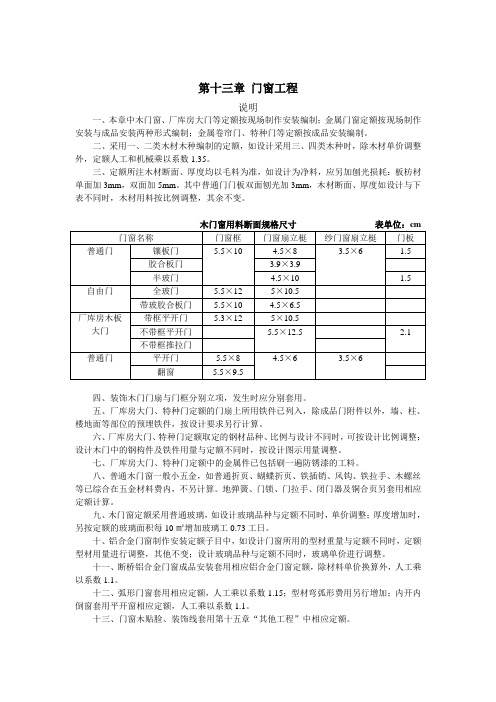
第十三章门窗工程说明一、本章中木门窗、厂库房大门等定额按现场制作安装编制;金属门窗定额按现场制作安装与成品安装两种形式编制;金属卷帘门、特种门等定额按成品安装编制。
二、采用一、二类木材木种编制的定额,如设计采用三、四类木种时,除木材单价调整外,定额人工和机械乘以系数1.35。
三、定额所注木材断面、厚度均以毛料为准,如设计为净料,应另加刨光损耗:板枋材单面加3mm,双面加5mm。
其中普通门门板双面刨光加3mm,木材断面、厚度如设计与下表不同时,木材用料按比例调整,其余不变。
四、装饰木门门扇与门框分别立项,发生时应分别套用。
五、厂库房大门、特种门定额的门扇上所用铁件已列入,除成品门附件以外,墙、柱、楼地面等部位的预埋铁件,按设计要求另行计算。
六、厂库房大门、特种门定额取定的钢材品种、比例与设计不同时,可按设计比例调整;设计木门中的钢构件及铁件用量与定额不同时,按设计图示用量调整。
七、厂库房大门、特种门定额中的金属件已包括刷一遍防锈漆的工料。
八、普通木门窗一般小五金,如普通折页、蝴蝶折页、铁插销、风钩、铁拉手、木螺丝等已综合在五金材料费内,不另计算。
地弹簧、门锁、门拉手、闭门器及铜合页另套用相应定额计算。
九、木门窗定额采用普通玻璃,如设计玻璃品种与定额不同时,单价调整;厚度增加时,另按定额的玻璃面积每10㎡增加玻璃工0.73工日。
十、铝合金门窗制作安装定额子目中,如设计门窗所用的型材重量与定额不同时,定额型材用量进行调整,其他不变;设计玻璃品种与定额不同时,玻璃单价进行调整。
十一、断桥铝合金门窗成品安装套用相应铝合金门窗定额,除材料单价换算外,人工乘以系数1.1。
十二、弧形门窗套用相应定额,人工乘以系数1.15;型材弯弧形费用另行增加;内开内倒窗套用平开窗相应定额,人工乘以系数1.1。
十三、门窗木贴脸、装饰线套用第十五章“其他工程”中相应定额。
工程量计算规则一、普通木门窗按设计门窗洞口面积计算,单独木门框按设计框外尺寸以延长米计算。
13--15个月教案
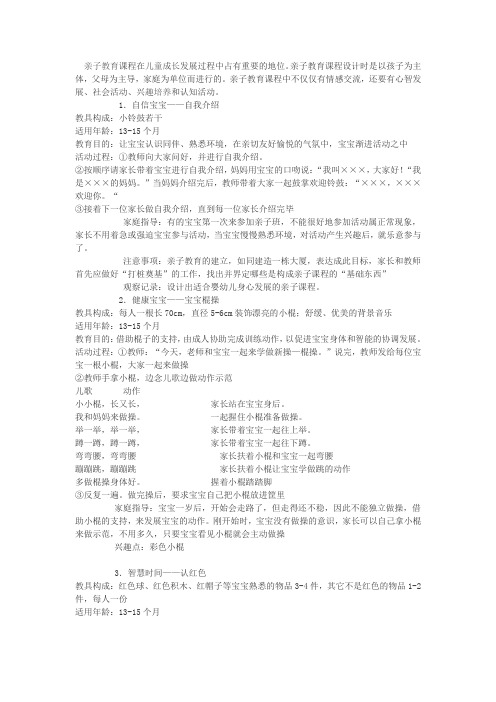
亲子教育课程在儿童成长发展过程中占有重要的地位。
亲子教育课程设计时是以孩子为主体,父母为主导,家庭为单位而进行的。
亲子教育课程中不仅仅有情感交流,还要有心智发展、社会活动、兴趣培养和认知活动。
1.自信宝宝——自我介绍教具构成:小铃鼓若干适用年龄:13-15个月教育目的:让宝宝认识同伴、熟悉环境,在亲切友好愉悦的气氛中,宝宝渐进活动之中活动过程:①教师向大家问好,并进行自我介绍。
②按顺序请家长带着宝宝进行自我介绍,妈妈用宝宝的口吻说:“我叫×××,大家好!“我是×××的妈妈。
”当妈妈介绍完后,教师带着大家一起鼓掌欢迎铃鼓:“×××,×××欢迎你。
“③接着下一位家长做自我介绍,直到每一位家长介绍完毕家庭指导:有的宝宝第一次来参加亲子班,不能很好地参加活动属正常现象,家长不用着急或强迫宝宝参与活动,当宝宝慢慢熟悉环境,对活动产生兴趣后,就乐意参与了。
注意事项:亲子教育的建立,如同建造一栋大厦,表达成此目标,家长和教师首先应做好“打桩奠基”的工作,找出并界定哪些是构成亲子课程的“基础东西”观察记录:设计出适合婴幼儿身心发展的亲子课程。
2.健康宝宝——宝宝棍操教具构成:每人一根长70cm,直径5-6cm装饰漂亮的小棍;舒缓、优美的背景音乐适用年龄:13-15个月教育目的:借助棍子的支持,由成人协助完成训练动作,以促进宝宝身体和智能的协调发展。
活动过程:①教师:“今天,老师和宝宝一起来学做新操—棍操。
”说完,教师发给每位宝宝一根小棍,大家一起来做操②教师手拿小棍,边念儿歌边做动作示范儿歌动作小小棍,长又长,家长站在宝宝身后。
我和妈妈来做操。
一起握住小棍准备做操。
举一举,举一举,家长带着宝宝一起往上举。
蹲一蹲,蹲一蹲,家长带着宝宝一起往下蹲。
弯弯腰,弯弯腰家长扶着小棍和宝宝一起弯腰蹦蹦跳,蹦蹦跳家长扶着小棍让宝宝学做跳的动作多做棍操身体好。
初一历史上同步13-15课答案
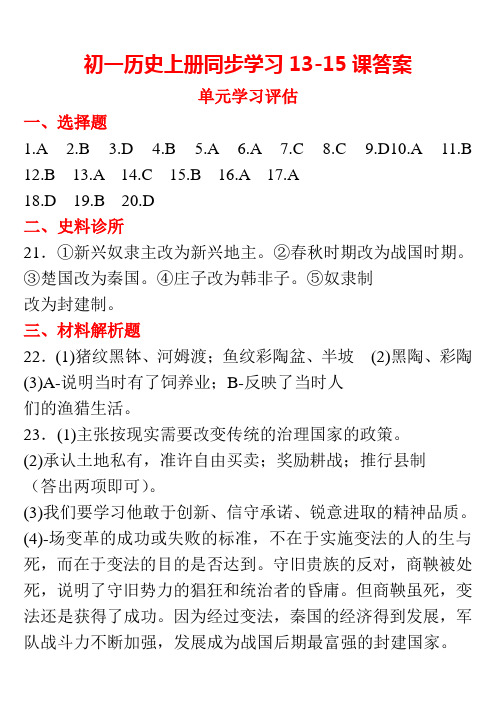
初一历史上册同步学习13-15课答案单元学习评估一、选择题1.A2.B3.D4.B5.A6.A7.C8.C9.D10.A 11.B 12.B 13.A 14.C 15.B 16.A 17.A18.D 19.B 20.D二、史料诊所21.①新兴奴隶主改为新兴地主。
②春秋时期改为战国时期。
③楚国改为秦国。
④庄子改为韩非子。
⑤奴隶制改为封建制。
三、材料解析题22.(1)猪纹黑钵、河姆渡;鱼纹彩陶盆、半坡(2)黑陶、彩陶(3)A-说明当时有了饲养业;B-反映了当时人们的渔猎生活。
23.(1)主张按现实需要改变传统的治理国家的政策。
(2)承认土地私有,准许自由买卖;奖励耕战;推行县制(答出两项即可)。
(3)我们要学习他敢于创新、信守承诺、锐意进取的精神品质。
(4)-场变革的成功或失败的标准,不在于实施变法的人的生与死,而在于变法的目的是否达到。
守旧贵族的反对,商鞅被处死,说明了守旧势力的猖狂和统治者的昏庸。
但商鞅虽死,变法还是获得了成功。
因为经过变法,秦国的经济得到发展,军队战斗力不断加强,发展成为战国后期最富强的封建国家。
24.(1)说明当时牛在生产中的重要性'牛耕普遍推广;(2)铁器;(3)史书记载,这一时期:公作则迟,分地则速,个体生产取代了大规模强制性集体耕作,个体小农逐渐成为社会的基本生产单位。
新兴地主阶级开始登上历史舞台。
25.(1)(南元谋人遗址——北京周口店人遗址——山顶洞人遗址——陕西半坡遗址——浙江河姆渡遗址——陕西黄帝陵(2)按年代顺序设计旅游路线,这种考查符合对历史事物的认识规律。
第三单元大一统的秦汉帝国第1 3课秦帝国的兴亡(一)自主评价1.B2.D3.C4.B5.B6.B7.B8.B9.C10.(1)陈胜,秦朝。
(2)陈胜吴广起义(秦末农民起义)是我国历史上第一次大规模的农民战争,它沉重打击了秦朝的残暴统治。
(二)拓展练习11c 12.A 13.C14.(1)秦国灭六国统一天下。
13-15年中医适宜技术考试卷及答案

2013年XX县中医药适宜技术推广考试试卷(一)医院:科室:姓名一、单项选择题。
(每题5分,共50分)1.穴位热敷现象不包括()A、透热B、扩热C、传热D、散热2.在小腿内侧,当足内踝尖上3寸,胫骨内侧缘后方的是()。
A、三阴交B、渎鼻C、足三里D、外膝眼3.雷火灸的作用不包括()A、活血化瘀B、祛风除湿C、消肿止痛D、通络散结4.钩活术疗法中局部放血目的是()A、祛瘀生新B、活血散结C、消肿止痛D、活血化瘀5.平衡针灸的作用机制就是针刺()A、中枢神经靶点B、外周神经靶点C、交感神经D、副交感神经6.带状疱疹常选用以下哪项疗法()A、平衡针B、火针C、铍针D、雷火灸法7.热敏灸疗法采用艾条悬灸的方法,可分为()A、单点温和灸、双点温和灸、三点温和灸、接力温和灸、循经温和灸。
8.钩活术疗法中进针钩治中不包括()A、钩治B、割治C、挑治D、灸疗9.头针疗法中治疗对侧下肢瘫痪选择的区域()A、运动区上2/5B、运动区中2/5C、运动区上1/5D、运动区中1/510.下列不属于头针疗法禁忌症的是()A 、孕妇B、囟门未完全闭合的婴幼儿C、70岁以上的老人D、心衰患者二、填空题:(每空2分,共40分)1. 针灸是和的合称。
2. 中医六腑是指:、、、、、。
3. 针法是把毫针按一定刺入患者体内,运用捻转与提插等针刺手法来治疗疾病。
4.毫针的结构分为 5 个部分: 、、、、。
5、中医六淫是指、、、、、。
三、判断题(每题2分,共10分)1.钩活术疗法常用于脊柱退行性()2.松解是根据治疗需要,用针刀在不同的解剖层次进行点刺、切割、剥离。
()3.脑出血患者应在急性期给予头针治疗以促进功能康复。
()4.火针应迅速准确进针,并迅速把针拔出,这一过程不超过一秒。
()5.平衡针触电式针感是指针刺后出现类似见电击样感觉,向近端放射。
()2013年XX县中医药适宜技术推广考试试卷(一)答案:一、选择题DADAB BADCC ADDCA二、填空题1.针法、灸法2. 胆,胃、大肠、小肠、膀胱、三焦3.穴位4. 针尖、针身、针根、针柄、针尾5. 风、寒、暑、湿,燥、火三、判断题√√×√×2013年XX县中医药适宜技术培训考试试题(二)一.单项选择题1、青黛散外用主治:()A,积滞 B.痛经. C.痄腮. D.泄泻.2、针刺中脘可治:()A,胁痛. B.感冒. C.咳嗽. D.中风.3、风寒咳嗽选用中成药:()A,羚羊清肺丸. B.川贝枇杷膏. C.二陈丸. D.通宣理肺丸.4、风寒感冒主证:()A.发热、咽喉疼痛、痰黄粘稠. B.鼻塞、时流清涕、痰清稀色白.C.年老或体虚、恶风寒、或发热、倦怠无力D.发执恶风、头身困重、胸脘痞闷.5、痰湿阻肺选用中成药:()6、A,羚羊清肺丸. B.川贝枇杷膏. C.二陈丸. D.通宣理肺丸.6、风热感冒主证:()A,发热、咽喉疼痛、痰黄粘稠. B.鼻塞、时流清涕、痰清稀色白.C.年老或体虚、恶风寒、或发热、倦怠无力D.发执恶风、头身困重、胸脘痞闷.7、视物眩转,头重如裹,胸闷恶心食少多寐,属那种证型眩晕。
水浒传13-15回的概括内容

《水浒传》第十三回到第十五回概括
第十三回:大闹史家村
概括:九纹龙史进回到家乡,遇到了猎户李吉,他前去拜访朱武。
在茶馆里,他遇到了神机军师朱武和跳涧虎陈达、白花蛇杨春。
三人决定一起上少华山入伙。
一行四人到了少华山,朱武等三人到庄上请王伦下山迎接新人,王伦不愿下山,众人劝说无果。
晚上,九纹龙和神机军师在放火烧官府,朱武、陈达、杨春将王伦杀死后投降了史进,众好汉一齐上了梁山泊。
第十四回:鲁智深大闹野猪林
概括:豹子头林冲因得罪了高太尉被刺配沧州。
陆虞候买通防送公人董超、薛霸,要于途中结果(杀害)林冲。
薛霸、董超一路上百般折磨林冲。
在野猪林,薛、董将林绑在树上,说明高太尉陆虞候指使他俩陷害林冲的根由,两人要用水火棍打死林冲。
鲁智深暗中保护,在野猪林救了林冲。
第十五回:小霸王醉入销金帐花和尚大闹桃花村
概括:小霸王周通想要强娶刘太公的女儿,刘太公不从,于是周通和“小霸王”打斗。
鲁智深前来帮忙,打了周通一顿。
周通逃走之后,鲁智深要镇关西郑屠亲自把“金钗退还给刘太公”。
鲁智深又到了大相国寺,职位被封为菜园子。
日本洪教头来挑衅,被鲁智深打倒在地。
鲁智深被林冲推荐为二龙山的寨主。
李逵杀死狄太公的女儿和奸夫王小二,独自到二龙山落草。
语文一年级下教案第二册13——15课
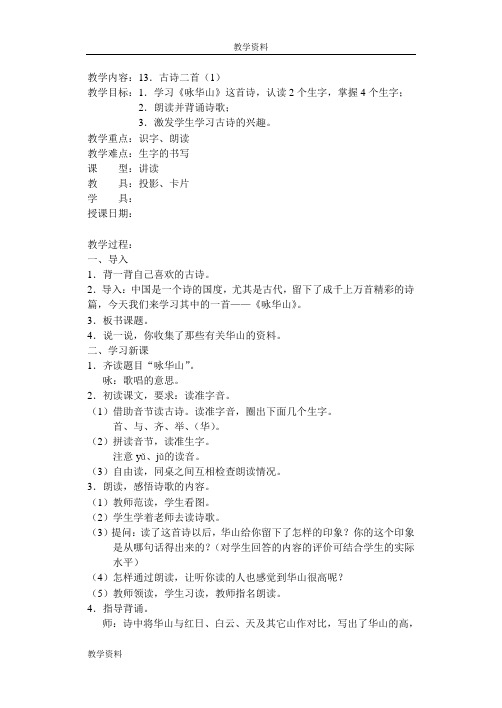
教学内容:13.古诗二首(1)教学目标:1.学习《咏华山》这首诗,认读2个生字,掌握4个生字;2.朗读并背诵诗歌;3.激发学生学习古诗的兴趣。
教学重点:识字、朗读教学难点:生字的书写课型:讲读教具:投影、卡片学具:授课日期:教学过程:一、导入1.背一背自己喜欢的古诗。
2.导入:中国是一个诗的国度,尤其是古代,留下了成千上万首精彩的诗篇,今天我们来学习其中的一首——《咏华山》。
3.板书课题。
4.说一说,你收集了那些有关华山的资料。
二、学习新课1.齐读题目“咏华山”。
咏:歌唱的意思。
2.初读课文,要求:读准字音。
(1)借助音节读古诗。
读准字音,圈出下面几个生字。
首、与、齐、举、(华)。
(2)拼读音节,读准生字。
注意yǔ、jǔ的读音。
(3)自由读,同桌之间互相检查朗读情况。
3.朗读,感悟诗歌的内容。
(1)教师范读,学生看图。
(2)学生学着老师去读诗歌。
(3)提问:读了这首诗以后,华山给你留下了怎样的印象?你的这个印象是从哪句话得出来的?(对学生回答的内容的评价可结合学生的实际水平)(4)怎样通过朗读,让听你读的人也感觉到华山很高呢?(5)教师领读,学生习读,教师指名朗读。
4.指导背诵。
师:诗中将华山与红日、白云、天及其它山作对比,写出了华山的高,了解了这些,有利于我们背诵课文。
学生试背,教师指名背。
5.小结。
6.书写生字。
(1)抽读卡片。
(2)自学笔顺(注意“字”的笔顺)。
(3)你觉得哪个字难记?你有什么好的方法记住它?(4)观察——描红——临写——指导。
(5)评议。
7.比一比,然后组词。
首()与()齐()举()自()写()文()兴()三、课堂总结学习了这首诗歌后,你有什么收获?板书设计:咏华山Shǒu yǔqí首与齐作业:背诵《咏华山》教学反思:教学内容:13.古诗二首(2)教学目标:1.学习《静夜思》这首诗,能结合诗句填空;2.认读4个生字,掌握2个生字,认识反文旁;3.激发学生喜爱古诗的兴趣。
七年级上册 历史复习总结 13—15课
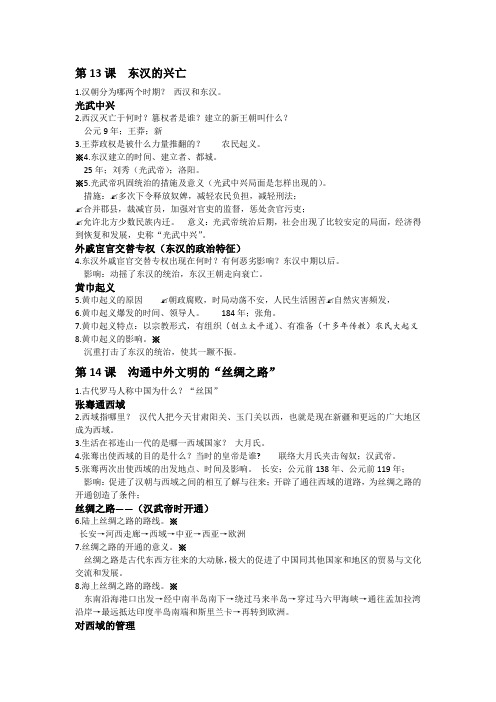
第13课东汉的兴亡1.汉朝分为哪两个时期?西汉和东汉。
光武中兴2.西汉灭亡于何时?篡权者是谁?建立的新王朝叫什么?公元9年;王莽;新3.王莽政权是被什么力量推翻的?农民起义。
※4.东汉建立的时间、建立者、都城。
25年;刘秀(光武帝);洛阳。
※5.光武帝巩固统治的措施及意义(光武中兴局面是怎样出现的)。
措施:✍多次下令释放奴婢,减轻农民负担,减轻刑法;✍合并郡县,裁减官员,加强对官吏的监督,惩处贪官污吏;✍允许北方少数民族内迁。
意义:光武帝统治后期,社会出现了比较安定的局面,经济得到恢复和发展,史称“光武中兴”。
外戚宦官交替专权(东汉的政治特征)4.东汉外戚宦官交替专权出现在何时?有何恶劣影响?东汉中期以后。
影响:动摇了东汉的统治,东汉王朝走向衰亡。
黄巾起义5.黄巾起义的原因✍朝政腐败,时局动荡不安,人民生活困苦✍自然灾害频发,6.黄巾起义爆发的时间、领导人。
184年;张角。
7.黄巾起义特点:以宗教形式,有组织(创立太平道)、有准备(十多年传教)农民大起义8.黄巾起义的影响。
※沉重打击了东汉的统治,使其一蹶不振。
第14课沟通中外文明的“丝绸之路”1.古代罗马人称中国为什么?“丝国”张骞通西域2.西域指哪里?汉代人把今天甘肃阳关、玉门关以西,也就是现在新疆和更远的广大地区成为西域。
3.生活在祁连山一代的是哪一西域国家?大月氏。
4.张骞出使西域的目的是什么?当时的皇帝是谁? 联络大月氏夹击匈奴;汉武帝。
5.张骞两次出使西域的出发地点、时间及影响。
长安;公元前138年、公元前119年;影响:促进了汉朝与西域之间的相互了解与往来;开辟了通往西域的道路,为丝绸之路的开通创造了条件;丝绸之路——(汉武帝时开通)6.陆上丝绸之路的路线。
※长安→河西走廊→西域→中亚→西亚→欧洲7.丝绸之路的开通的意义。
※丝绸之路是古代东西方往来的大动脉,极大的促进了中国同其他国家和地区的贸易与文化交流和发展。
8.海上丝绸之路的路线。
二十四式太极拳13---15式.doc

结束部分
时间:(3分钟)组织:四列横队
1、听音乐跟老师一起放松。
2、教师总体评价,多以激励性评价为主。
3、回收器材和场地垃圾,师生再见。
预计平均心率为约120——130次/分,整堂课练习密度约为:35--40%。
要求:
1、学生认真听讲,明确本课目标任务和要求,提高安全意识
2、整队快、静、齐。
3、情感目标:培养学生对中国传统武术的兴趣,提高学生的武德修养,加强学生的爱国主义精神和民族自豪感;培养学生的团结协作、相互帮助、乐于合作的精神。
【重点】
跟步、虚步、弓步分手、分手蹬脚、弓步贯拳、屈膝落手。
【难点】
重心平稳、柔和圆滑。
【场地器材】
田径场、录音机一台、小黑板一块、20个矿泉水瓶。
自主探究、学习
3、巡回耐心指导,关注学生个体差异。
三、“我最棒”比赛活动,各小组展示与评价,感受成功的喜悦。
(一)小组展示。以组为单位将13——15式的动作进行展示,培养和提高学生自信心和团结协作的精神,帮助学生提高心理素质。
(二)小组互评。培养学生能够客观分析和评价自我能力,做到平时在评价身边人和事时努力做到既不自高自大也不妄自菲薄。
3、互帮互学,相互鼓励,共同进步。
易犯错误:
1、重心不稳忽高忽低。
2、动作生硬
3、上下肢配合不协调
要求:
1、在音乐伴奏下进行放松练习
2、听老师点评本课,共同参与,并认真思考,了解自身优缺点。
3、听老师布置课外作业。
4、收器材,师生再见。
ห้องสมุดไป่ตู้课前预习
利用电脑观看24式太极拳视频并体会到动作的柔和、圆滑。
准备活动和导入阶段
时间:(5分钟)
13-15二笔实务真题+译文 via 喵仔门徒帮
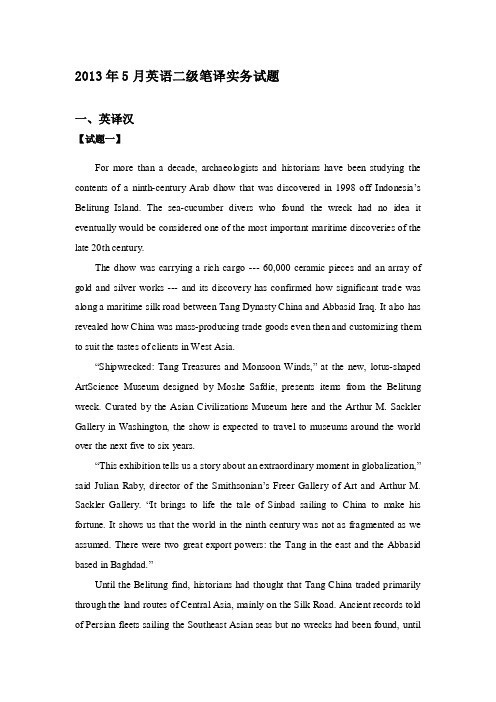
2013年5月英语二级笔译实务试题一、英译汉【试题一】For more than a decade, archaeologists and historians have been studying the contents of a ninth-century Arab dhow that was discovered in 1998 off Indonesia’s Belitung Island. The sea-cucumber divers who found the wreck had no idea it eventually would be considered one of the most important maritime discoveries of the late 20th century.The dhow was carrying a rich cargo --- 60,000 ceramic pieces and an array of gold and silver works --- and its discovery has confirmed how significant trade was along a maritime silk road between Tang Dynasty China and Abbasid Iraq. It also has revealed how China was mass-producing trade goods even then and customizing them to suit the tastes of clients in West Asia.“Shipwrecked: Tang Treasures and Monsoon Winds,” at the new, lotus-shaped ArtScience Museum designed by Moshe Safdie, presents items from the Belitung wreck. Curated by the Asian Civilizations Museum here and the Arthur M. Sackler Gallery in Washington, the show is expected to travel to museums around the world over the next five to six years.“This exhibition tells us a story about an extraordinary moment in globalization,” said Julian Raby, director of the Smithsonian’s Freer Gallery of Art and Arthur M. Sackler Gallery. “It brings to life the tale of Sinbad sailing to China to make his fortune. It shows us that the world in the ninth century was not as fragmented as we assumed. There were two great export powers: the Tang in the east and the Abbasid based in Baghdad.”Until the Belitung find, historians had thought that Tang China traded primarily through the land routes of Central Asia, mainly on the Silk Road. Ancient records told of Persian fleets sailing the Southeast Asian seas but no wrecks had been found, untilthe Belitung dhow. Its cargo confirmed that a huge volume of trade was taking place along a maritime route, said Heidi Tan, a curator at the Asian Civilizations Museum and a curator of the exhibition.Mr. Raby said: “The size of the find gives us a sense of two things: a sense of China as a country already producing things on an industrialized scale and also a China that is no longer producing ceramics to bury.” He was referring to the production of burial pottery like camels and horses, which was banned in the late eighth century. “Instead, kilns looked for other markets and they started producing tableware and they built an export market.”【试题二】Madeira is more than 500 kilometers from the African coast and is officially one of the “outermost regions” of the European Union. Despite that far-flung status, Madeira catapulted into the center of the Union’s agricultural and environmental affairs last year when Portugal asked the European Commission for permission to impose an unprecedented ban on growing biotech crops there.Last week, the commission quietly let the deadline pass for opposing Portugal’s request, allowing Madeira, which is one of Portugal’s autonomous regions, to become the first E.U. territory to get formal permission from Brussels to remain entirely free of genetically modified organisms. Madeira now will probably go ahead and implement the ban, a spokeswoman for the Portuguese government said Friday.Individual European countries and regions have banned certain genetically modified crops before. Many consumers and farmers in countries like Austria, France and Italy regard the crops as potentially dangerous and likely to contaminate organically produced food. But the case of Madeira represents a significant landmark, because it is the first time the commission, which runs the day-to-day affairs of the European Union, has permitted a country to impose such a sweeping and definitive rejection of the technology.The Madeirans’ main concerns focused on preserving the archipelago’s biodiversity and its forest of subtropical laurel trees. Such forests, known as laurisilva, were once widespread on the European mainland but were wiped out thousands of years ago during an earlier period of climate change. That has left Madeira with “much the largest extent of laurel forest surviving in the world, with a unique suite of plants and animals,” according to the United Nations Educational, Scientific and Cultural Organization, which named the Madeiranlaurisilva a World Heritage Site in 1999. The forest also is a growing attraction for tourists, who make up a significant portion of Madeira’s earnings.In seeking to ban biotechnology on Madeira, the Portuguese government told the commission that it would be impossible to separate crops containing genetically engineered material from other plant life. The “risk to nature presented by the deliberate release of GMOs is so dangerous and poses such a threat to the environmental and ecological health of Madeira, that it is not worthwhile risking their use, either directly in the agricultural sector or even on an experimental basis,” the Portuguese told the commission.二、汉译英【试题一】稀土是中国最丰富的战略资源,截止2009年,中国稀土储量达到3600万吨,占到全球稀土储量的36.4%。
六年级英语13--15课教案
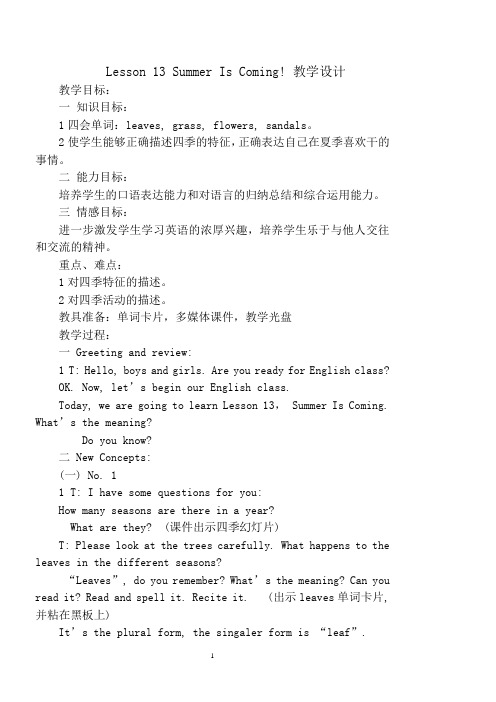
Lesson 13 Summer Is Coming! 教学设计教学目标:一知识目标:1四会单词:leaves, grass, flowers, sandals。
2使学生能够正确描述四季的特征,正确表达自己在夏季喜欢干的事情。
二能力目标:培养学生的口语表达能力和对语言的归纳总结和综合运用能力。
三情感目标:进一步激发学生学习英语的浓厚兴趣,培养学生乐于与他人交往和交流的精神。
重点、难点:1对四季特征的描述。
2对四季活动的描述。
教具准备:单词卡片,多媒体课件,教学光盘教学过程:一 Greeting and review:1 T: Hello, boys and girls. Are you ready for English class?OK. Now, let’s begin our English class.Today, we are going to learn Lesson 13, Summer Is Coming. What’s the meaning?Do you know?二 New Concepts:(一) No. 11 T: I have some questions for you:How many seasons are there in a year?What are they? (课件出示四季幻灯片)T: Please look at the trees carefully. What happens to the leaves in the different seasons?“Leaves”, do you remember? What’s the meaning? Can you read it? Read and spell it. Recite it. (出示leaves单词卡片, 并粘在黑板上)It’s the plural form, the singaler form is “leaf”.T: Look at the leaves in winter? Do the trees have any leaves in winter?(The trees don’t have any leaves in winter.) (板书 The trees ------ leaves in ------.)T: How about in spring? Do the trees have any leaves in spring? Are the leaves new or old?(Yes, the trees have new leaves in spring.)T: What colour are summer leaves? (green)Do you know summer leaves can make you cool?So, trees have cool, green leaves in summer. Say it, please.T: Look at the leaves in fall. Do the trees have cool, green leaves in fall?The trees lose their leaves in fall.“lose”, what’s the meaning? Here, it means “失去”.What colour are fall leaves? (yellow, orange, red)T: Class, different seasons, different trees and leaves. Can you say the differences about the leaves ?2 T: Now, let’s talk about the weather of the four seasons.How’s the weather in winter? (cold and snowy) (板书 The weather is ------- in ------.)In spring? (warm and rainy)What are these? Do you like spring flowers?(出示单词卡片flowers, 并领读,拼读,背诵单词)How’s the weather in summer?Is the weather hot and sunny in fall?3 T: This time, can you tell me the clothes you wear in the four seasons?What do you wear in summer? (板书 I wear my -------- in -------.)(在学生回答时,适时出示单词sandals, 并领读,拼读,背诵单词。
《孔子是怎样炼成的》13-15集知识点提炼

《孔子是怎样炼成的》13-15集知识点第十三集圣人的境界★知识类季桓子临终遗言,希望其子做鲁国执政后能把孔子召回来。
季桓子死后,季孙肥执政,想起父亲遗言,本想召孔子回国,但最终在小人公之鱼的挑拨唆使之下,放弃了把孔子召回国的念头,为求折中,把孔子的学生冉求召回国。
★启示类一、关于小人解析:(一)大人有大人的思路,小人有小人的想法。
小人的想法往往比大人的思路更能打动人心,因为小人的想法往往针对的是我们人性中的弱点。
(二)小人见不得别人有优点,他宁愿别人都有各种各样的不足,小人常常是因为别人的优点而生气。
(三)小人看到别人的缺点会幸灾乐祸,而君子看到别人有弱点、不足就像他自己有弱点有不足一样,他很同情、怜悯、慈悲。
二、推其长处,违其短者解析:当你知道某人有某方面弱点的时候,你就不要在这方面去触犯他。
他哪一方面有优点,你把它推出去,让别人都知道这人有优点;他哪一方面有缺点,你一定要注意帮着他去掩盖,这样交朋友才能交到长久的朋友。
别人的缺点不是我们指责的对象,不是我们幸灾乐祸的对象,是我们恰恰要加以呵护的对象,呵护别人的缺点就像呵护别人的伤口一样,这才是一种境界。
三、大道容下,大德容众解析:一个人的情怀、气质、风度一定在自由的环境下才能够发育,孔子手下那么多学生,各有各的个性、气质、风度、性情,说明孔子一定是宽容的。
四、忠恕之道解析:恕--“己所不欲,勿施于人”。
自己不想要的,不要强加给别人;忠--“己欲立而立人,己欲达而达人。
”你想要的也得要帮助别人实现。
恕是消极的道德,忠是积极的道德。
忠就是做对别人有益的事,恕就是不做对别人有害的事。
做对别人有益的事你必须要有这个能力,而不做对别人有害的事不需要能力。
忠有个前提,即我们有共同的爱好、共同的追求。
五、知礼解析:孔子不愿用具体的人来说明问题,因为用具体的人来说明问题就相当于在指责这人。
孔子知道你是错的但他不愿批评你,他对别人更多的是理解和同情。
孔子不仅明礼仪而且知人心。
九年级物理:第13-15章知识点总结
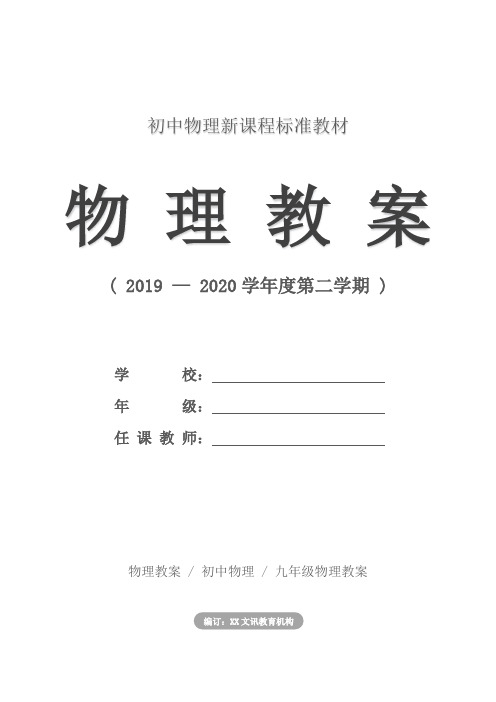
初中物理新课程标准教材物理教案( 2019 — 2020学年度第二学期 )学校:年级:任课教师:物理教案 / 初中物理 / 九年级物理教案编订:XX文讯教育机构第13-15章知识点总结教材简介:本教材主要用途为通过学习物理知识,可以让学生培养自己的逻辑思维能力,对事物的理解认识也会有一定的帮助,本教学设计资料适用于初中九年级物理科目, 学习后学生能得到全面的发展和提高。
本内容是按照教材的内容进行的编写,可以放心修改调整或直接进行教学使用。
第十三章电功和电功率1.电功(w):电路中电流所做的功叫电功,表示电流做功多少的物理量。
2.电功的国际单位:焦耳。
常用单位有:度(千瓦时),1度=1千瓦时=3.6×106焦耳。
3.测量电功的工具:电能表(电度表)4.电功计算公式:w=uit(式中单位w→焦(j);u→伏(v);i→安(a);t→秒)。
5.利用w=uit计算电功时注意:①式中的w.u.i和t是在同一段电路;②计算时单位要统一;③已知任意的三个量都可以求出第四个量。
6.计算电功还可用以下公式:w=i2rt ;w=pt;w=u2 /r*t7.电功率(p):电流在单位时间内做的功。
表示电流做功快慢的物理量.单位有:瓦特(国际);常用单位有:千瓦8.计算电功率公式:p =w/t ;p=ui ; 式中单位p→瓦(w);w→焦;t→秒;u→伏(v);i→安(a)9.利用p = 计算时单位要统一,①如果w用焦、t用秒,则p的单位是瓦;②如果w 用千瓦时、t用小时,则p的单位是千瓦。
10.计算电功率还可用公式:p=i2r和p= u2 /r11.额定电压(u0):用电器正常工作的电压。
12.额定功率(p0):用电器在额定电压下的功率。
13.实际电压(u):实际加在用电器两端的电压。
14.实际功率(p):用电器在实际电压下的功率。
当u > u0时,则p > p0 ;灯很亮,易烧坏。
当u q 计算产生的热量只能用:q= i 2rt 计算电功只能用:w = u i t第十四章电磁现象1.磁性:物体吸引铁、镍、钴等物质的性质。
《海底两万里》第13-15章的内容概括

《海底两万里》第13-15章的内容概括全文共3篇示例,供读者参考《海底两万里》的主要内容是叙述法国生物学家阿龙纳斯教授在深海旅行的故事。
故事的`起因是年所发生的一件闹得满城风雨的怪事。
当时不少航行船只在海上发现了一头大“海怪”,并有船只遭到“海怪”的袭击。
出于对航海安全的考虑,也是在公众的呼吁下,由美国派遣了一艘战舰对“海怪”进行追逐。
法国生物学家阿龙纳斯教授受邀参加了这次追逐行动。
结果,追逐怪物的战舰反被怪物追逐,并遭到“海怪”的凶猛袭击。
阿龙纳斯教授和他的两位同伴落水,被“海怪”所救,此后便跟随“海怪”周游四海,探尽海底秘密,历尽艰辛和风险。
最后,他们因不堪海底世界过于沉闷的生活,又设法逃走,重回陆地。
故事并不复杂:故事发生在年,法国人阿龙纳斯,一位生物学家,应邀赴美参加一项科学考察活动。
这时,海上出了个怪物,在全世界闹得沸沸扬扬。
科考活动结束之后,生物学家正准备束装就道,返回法国,却接到美国海军部的邀请,于是改弦更张,登上了一艘驱逐舰林肯号,参与“把那个怪物从海洋中清除出去”的活动。
经过千辛万苦,“怪物”未被清除,驱逐舰反被“怪物”重创,生物学家和他的仆人康赛尔以及为清除“怪物”被特意请到驱逐舰上来的一名捕鲸手尼德兰,都成了“怪物”的俘虏!结果发现“怪物”是一艘尚不为世人所知的潜水艇,名“诺第留斯”(“鹦鹉螺”)号。
潜艇对俘虏倒也优待;只是,为了保守自己的'秘密,潜艇艇长尼摩从此永远不许他们离开。
阿龙纳斯一行别无选择,只能跟着潜水艇周游各大洋。
十个月之后,这三个人终于在极其险恶的情况下逃脱,生物学家才得以把这件海底秘密公诸于世。
年,在海上发现了一头被认为是独角鲸的大怪物。
法国生物学家阿龙纳斯应邀参加追捕。
追捕过程中,阿龙纳斯、他的仆人康塞尔和捕鲸叉手尼德·兰三人,发现这怪物不是什么独角鲸,而是一艘构造奇妙的潜艇。
潜艇船长尼摩,是个不明国籍、自称“跟整个人类断绝了关系”的神秘人物,身材高大,神情自信、坚毅。
西游记13到15回心得体会多篇
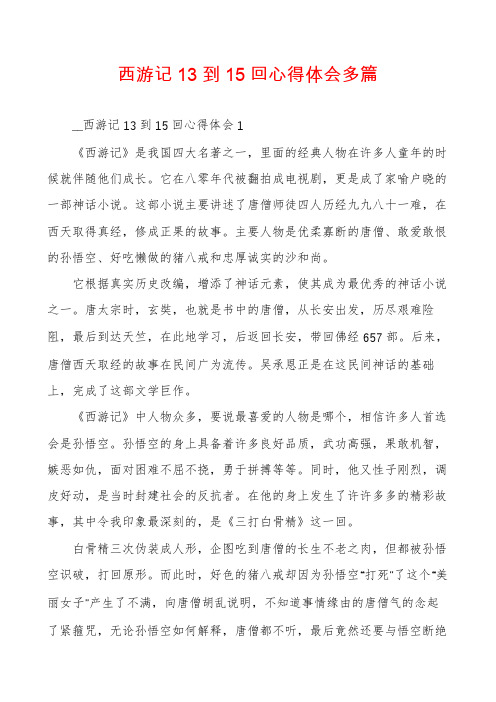
西游记13到15回心得体会多篇__西游记13到15回心得体会1《西游记》是我国四大名著之一,里面的经典人物在许多人童年的时候就伴随他们成长。
它在八零年代被翻拍成电视剧,更是成了家喻户晓的一部神话小说。
这部小说主要讲述了唐僧师徒四人历经九九八十一难,在西天取得真经,修成正果的故事。
主要人物是优柔寡断的唐僧、敢爱敢恨的孙悟空、好吃懒做的猪八戒和忠厚诚实的沙和尚。
它根据真实历史改编,增添了神话元素,使其成为最优秀的神话小说之一。
唐太宗时,玄奘,也就是书中的唐僧,从长安出发,历尽艰难险阻,最后到达天竺,在此地学习,后返回长安,带回佛经657部。
后来,唐僧西天取经的故事在民间广为流传。
吴承恩正是在这民间神话的基础上,完成了这部文学巨作。
《西游记》中人物众多,要说最喜爱的人物是哪个,相信许多人首选会是孙悟空。
孙悟空的身上具备着许多良好品质,武功高强,果敢机智,嫉恶如仇,面对困难不屈不挠,勇于拼搏等等。
同时,他又性子刚烈,调皮好动,是当时封建社会的反抗者。
在他的身上发生了许许多多的精彩故事,其中令我印象最深刻的,是《三打白骨精》这一回。
白骨精三次伪装成人形,企图吃到唐僧的长生不老之肉,但都被孙悟空识破,打回原形。
而此时,好色的猪八戒却因为孙悟空“打死”了这个“美丽女子”产生了不满,向唐僧胡乱说明,不知道事情缘由的唐僧气的念起了紧箍咒,无论孙悟空如何解释,唐僧都不听,最后竟然还要与悟空断绝师徒关系。
悟空无奈,回到了花果山。
后来,唐僧遇难,悟空心系师父安慰,前去营救,最终又回到了西天取经的队伍。
当唐僧不听悟空解释并要断绝关系的时候,他却将委屈埋在心底,不计前嫌的去挽救师傅的生命,可见他对唐僧的一片真心。
孙悟空的这种知恩图报,不计较的精神值得大家学习。
同时在学习中,我们也应该奋发图强,面对挫折迎难而上。
就像孙悟空的扮演者六小龄童所说:“苦练七十二变,笑对八十一难!”__西游记13到15回心得体会2第一次看到西游记(儿童版)是小学三年级,我看得津津有味。
西游记13到15回心得体会精选
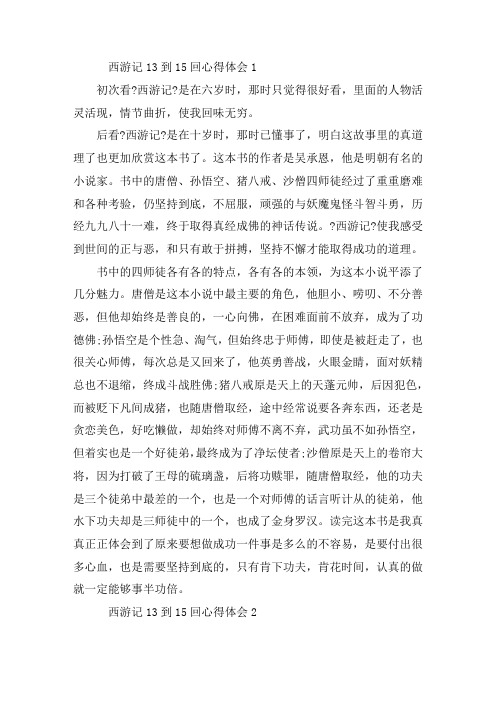
西游记13到15回心得体会1初次看?西游记?是在六岁时,那时只觉得很好看,里面的人物活灵活现,情节曲折,使我回味无穷。
后看?西游记?是在十岁时,那时已懂事了,明白这故事里的真道理了也更加欣赏这本书了。
这本书的作者是吴承恩,他是明朝有名的小说家。
书中的唐僧、孙悟空、猪八戒、沙僧四师徒经过了重重磨难和各种考验,仍坚持到底,不屈服,顽强的与妖魔鬼怪斗智斗勇,历经九九八十一难,终于取得真经成佛的神话传说。
?西游记?使我感受到世间的正与恶,和只有敢于拼搏,坚持不懈才能取得成功的道理。
书中的四师徒各有各的特点,各有各的本领,为这本小说平添了几分魅力。
唐僧是这本小说中最主要的角色,他胆小、唠叨、不分善恶,但他却始终是善良的,一心向佛,在困难面前不放弃,成为了功德佛;孙悟空是个性急、淘气,但始终忠于师傅,即使是被赶走了,也很关心师傅,每次总是又回来了,他英勇善战,火眼金睛,面对妖精总也不退缩,终成斗战胜佛;猪八戒原是天上的天蓬元帅,后因犯色,而被贬下凡间成猪,也随唐僧取经,途中经常说要各奔东西,还老是贪恋美色,好吃懒做,却始终对师傅不离不弃,武功虽不如孙悟空,但着实也是一个好徒弟,最终成为了净坛使者;沙僧原是天上的卷帘大将,因为打破了王母的硫璃盏,后将功赎罪,随唐僧取经,他的功夫是三个徒弟中最差的一个,也是一个对师傅的话言听计从的徒弟,他水下功夫却是三师徒中的一个,也成了金身罗汉。
读完这本书是我真真正正体会到了原来要想做成功一件事是多么的不容易,是要付出很多心血,也是需要坚持到底的,只有肯下功夫,肯花时间,认真的做就一定能够事半功倍。
西游记13到15回心得体会2我曾经一遍又一遍地看那的电视连续剧——?西游记?。
而最近,老师又让我们看?西游记?这本书,这让我不禁有点厌倦,因为已经看了很多遍了,再看也没意思了。
周末没什么事干,我便静下心来,坐在家里拿起?西游记?开始仔细看。
我把?西游记?一书认真地看了一会,这时才让我真正领略到?西游记?的文字所带来的魅力,我便对它又充满了兴趣。
